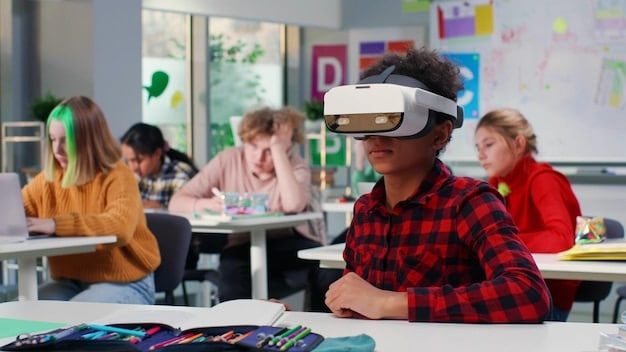Gen Z’s Digital Literacy: Enhancing Learning Outcomes for Educators

Educators can effectively leverage Gen Z’s inherent digital literacy by integrating technology-driven pedagogies, fostering collaborative online learning environments, and promoting critical media evaluation to enhance engagement and deepen understanding across diverse educational settings.
The landscape of education is continuously reshaped by evolving digital natives. Generation Z, born into an era of ubiquitous internet access and interconnected devices, possesses an innate familiarity with digital tools and platforms. Understanding how can educators leverage Gen Z’s digital literacy to enhance learning outcomes is not merely an optional pedagogical approach, but a critical imperative for fostering engagement and driving academic success in the modern classroom.
Understanding Gen Z’s Digital Landscape and Learning Styles
Generation Z, broadly defined as individuals born between the mid-1990s and the early 2010s, exhibits a profound connection to digital technology that shapes their worldview and learning preferences. Unlike previous generations who adopted technology, Gen Z grew up immersed in it, making them “digital natives” in the truest sense. This pervasive digital presence has cultivated unique learning styles and expectations within this demographic.
They are characterized by their comfort with multimodal content consumption, often juggling multiple screens and information streams simultaneously. Their attention spans are adapted to quick, visually rich content, favoring platforms like TikTok, YouTube, and Instagram for information and entertainment. This isn’t to say their attention is inherently short, but rather it’s selective and demands immediate relevance and engagement. Traditional didactic methods, therefore, often fall flat with this group, leading to disengagement and a perceived lack of foundational understanding.
Navigating the Digital Realm: Intuition and Skepticism
While Gen Z is adept at navigating digital interfaces, their ‘digital literacy’ is not uniform. It often encompasses intuitive user experience but sometimes lacks critical evaluation skills regarding online information. Educators have a crucial role in bridging this gap, transforming mere digital fluency into thoughtful, responsible digital citizenship. Recognizing this nuanced relationship with technology is the first step toward effective instructional design.
- They prefer active, exploratory learning over passive reception.
- Visual and interactive content resonates deeply with their learning styles.
- Collaboration and peer-to-peer learning are often more appealing than individual work.
- Instant feedback and personalized learning pathways motivate them.
Their learning journey is often self-directed, driven by a desire for immediate answers and practical application. They are accustomed to crowdsourcing information, collaborating online, and using digital tools to solve problems, albeit sometimes without fully grasping the underlying principles. This intrinsic motivation, when channeled correctly, can become a powerful asset in the educational process, turning what might seem like a distraction into a valuable learning opportunity.
Integrating Digital Tools and Platforms into Pedagogy
Leveraging Gen Z’s digital literacy requires a deliberate shift in pedagogical approaches, moving beyond simply using technology to fundamentally integrating it into the learning process. This involves selecting appropriate digital tools and platforms that align with educational objectives while simultaneously resonating with Gen Z’s digital comfort zone. The aim is not to replace traditional teaching but to enhance it, creating a hybrid learning experience.
Interactive presentations, gamified learning environments, and multimedia resources can significantly boost engagement. Platforms like Nearpod, Kahoot!, or educational apps can transform static content into dynamic activities that captivate students’ attention. Moreover, incorporating social media tools, not as distractions but as learning instruments, can be incredibly powerful. Imagine students creating short educational videos for TikTok or curating academic resources on Pinterest.
Designing Interactive and Collaborative Learning Experiences
Beyond content delivery, digital tools can facilitate collaborative learning, a cornerstone of Gen Z’s social inclinations. Online discussion forums, collaborative document editing (e.g., Google Docs), and project management tools (e.g., Trello) allow students to work together seamlessly, mirroring the collaborative environments they encounter in their daily digital lives. These platforms foster peer-to-peer learning, communication skills, and collective problem-solving, all while developing digital competencies.
- Utilize learning management systems (LMS) for personalized content delivery and progress tracking.
- Implement virtual reality (VR) or augmented reality (AR) for immersive learning experiences.
- Encourage student-generated content using digital storytelling tools or video editing software.
Educators can design assignments that explicitly require students to use digital research methods, create digital portfolios, or participate in online academic discussions. This not only leverages their existing skills but also refines them, teaching them how to use these tools for academic rigor and professional development. The focus should be on practical application and real-world relevance, which Gen Z greatly values.

Fostering Critical Digital Literacy and Information Evaluation
While Gen Z possesses inherent digital fluency, their critical digital literacy—the ability to evaluate, synthesize, and create information responsibly—often requires explicit instruction. In an age of widespread misinformation and deepfakes, teaching students to discern credible sources from unreliable ones is paramount. This skill extends beyond basic fact-checking to understanding bias, recognizing propaganda, and appreciating the nuances of digital communication.
Educators can integrate activities that challenge students to analyze news articles, social media posts, or online videos for accuracy, authoritativeness, and intent. This might involve comparing multiple sources on a controversial topic, identifying logical fallacies, or tracing the origin of viral information. By doing so, students move from passive consumption to active, critical engagement with digital content, a vital skill for academic success and informed citizenship.
Developing Digital Citizenship and Ethical Use
Beyond critical evaluation, fostering strong digital citizenship is essential. This includes understanding online privacy, recognizing the permanence of digital footprints, and practicing ethical online behavior. Educators can facilitate discussions around cyberbullying, digital etiquette, and intellectual property rights in the digital space. Role-playing scenarios or case studies can help students grapple with complex ethical dilemmas they might encounter online.
- Teach lateral reading strategies to verify information across multiple tabs.
- Discuss the algorithms that shape online information consumption and potential biases.
- Implement projects requiring students to cite digital sources meticulously and ethically.
By explicitly addressing these aspects of digital literacy, educators empower Gen Z not just to use technology, but to use it wisely and responsibly. This involves moving beyond the mechanics of digital tools to the deeper understanding of their societal impact and the individual’s role within the digital ecosystem. Equipping students with these critical skills prepares them for a future where digital discernment is as important as traditional academic knowledge.
Personalized Learning Pathways and Adaptive Technologies
Gen Z thrives on personalization. Having grown up with algorithms that tailor content to their preferences on streaming services and social media, they expect a similar level of individualized experience in their learning. Educators can leverage this expectation by implementing personalized learning pathways and adaptive technologies that cater to diverse learning paces and styles, significantly enhancing learning outcomes.
Adaptive learning platforms, powered by artificial intelligence, can assess a student’s current understanding and adjust the difficulty and type of content accordingly. This allows high-achievers to move ahead at their own pace and provides additional support for those who need it, ensuring that every student is challenged appropriately. Such systems can also identify knowledge gaps and recommend specific resources or activities to address them, making learning more efficient and targeted.
Data-Driven Insights for Individualized Instruction
The data generated by these platforms provides invaluable insights for educators. They can track individual student progress, pinpoint common areas of difficulty, and identify students who might be struggling before they fall too far behind. This data-driven approach allows for timely interventions and more informed instructional decisions, moving away from a one-size-fits-all model towards truly individualized teaching.
- Utilize online modules and resources that students can access at their own pace.
- Implement mastery-based learning where students progress only after demonstrating proficiency.
- Encourage students to set personal learning goals and track their own progress digitally.
Personalized learning also extends to allowing students choice in how they demonstrate their understanding. Instead of solely traditional essays or exams, offering options like video presentations, digital projects, or podcasts can tap into Gen Z’s digital expressive capabilities. This autonomy not only increases engagement but also fosters a sense of ownership over their learning journey, leading to deeper understanding and greater retention.
Gamification and Experiential Learning
Gamification taps directly into Gen Z’s innate affinity for interactive, challenge-driven experiences. By incorporating game-like elements into educational activities, educators can significantly boost motivation, engagement, and ultimately, learning outcomes. This isn’t about simply playing games in class, but about applying game design principles to learning contexts, making academic tasks feel more like achievable quests.
Elements such as points, badges, leaderboards, and clear progression paths can transform mundane assignments into exciting challenges. For instance, a history lesson could involve students “unlocking” new historical eras by completing tasks, or a science project could be framed as a mission to solve a real-world problem. Instant feedback, a hallmark of digital gaming, is crucial here; students want to know immediately how they are performing, allowing them to adjust their strategies quickly.
Simulations, Virtual Reality, and Real-World Application
Beyond traditional gamification, experiential learning using simulations and virtual reality (VR) offers unparalleled opportunities. VR field trips can transport students to ancient civilizations, inside the human body, or to distant galaxies, providing immersive experiences that would be impossible in a conventional classroom. Educational simulations allow students to experiment with complex concepts in a safe, controlled environment, learning through trial and error.
- Design classroom activities with clear objectives, challenges, and rewards to mimic game structures.
- Utilize educational apps that incorporate gamified elements for practice and review.
- Encourage the use of open-world simulation games (e.g., Minecraft Education Edition) for project-based learning.
These approaches not only make learning more fun and memorable but also cater to Gen Z’s preference for hands-on, active learning. By directly experiencing concepts, students develop a deeper intuitive understanding and are better able to apply what they’ve learned to new situations. The emphasis shifts from memorization to genuine comprehension and skill development, preparing them for real-world challenges.

Empowering Student Voice and Co-Creation of Content
Generation Z values authenticity, agency, and the opportunity to express themselves. Rather than being passive recipients of information, they thrive when given a voice and the chance to contribute meaningfully to their learning environment. Educators can leverage this by empowering students to co-create content, share their perspectives, and shape aspects of their learning journey.
This approach moves beyond traditional student presentations; it involves inviting students to design learning activities, curate resources, or even contribute to the curriculum. For example, students could be tasked with creating educational videos for their peers, developing interactive quizzes, or building collaborative digital encyclopedias on course topics. This not only reinforces their own understanding but also allows them to exercise their digital storytelling and creative skills.
Student-Led Discussions and Peer Mentorship
Encouraging student-led discussions, both online and offline, is another powerful strategy. Gen Z is comfortable communicating in digital spaces, and providing structured opportunities for them to lead discussions, debate ideas, and offer peer feedback can foster deeper critical thinking and communication skills. Digital platforms can facilitate these interactions, allowing for asynchronous participation and thoughtful reflection.
- Provide opportunities for students to choose presentation formats, including podcasts, infographics, or interactive websites.
- Implement peer-teaching initiatives where digitally fluent students can mentor others.
- Create classroom blogs or wikis where students can contribute and collaboratively build knowledge.
When students are given ownership over their learning, they become more invested and motivated. Co-creation of content taps into their digital native abilities and encourages them to use technology as a tool for expression and teaching, not just consumption. This not only enhances academic outcomes but also builds essential 21st-century skills like creativity, collaboration, and self-direction, preparing them for future academic and professional endeavors.
Professional Development for Educators and Future Readiness
For educators to effectively leverage Gen Z’s digital literacy, ongoing professional development is not just beneficial, but essential. Many educators, particularly those from older generations, may not share the same intuitive understanding of digital tools and platforms as their students. Bridging this digital divide within the teaching staff is crucial for consistent and effective integration of technology into the curriculum.
Professional development programs should focus not only on the technical skills required to use new digital tools but also on the pedagogical shifts needed to incorporate them meaningfully. This includes workshops on active learning strategies, project-based learning with a digital component, and fostering critical digital literacy. It is about understanding the “why” behind the technology, not just the “how.”
Building a Culture of Continuous Learning and Adaptation
Furthermore, educators need support in developing future-ready skills that extend beyond current technologies. The digital landscape evolves rapidly, and what is cutting-edge today may be obsolete tomorrow. Therefore, fostering a mindset of continuous learning, adaptability, and experimental pedagogy is vital. This involves encouraging educators to explore new tools, share best practices, and even learn alongside their students.
- Provide regular training on new educational technologies and best practices for digital integration.
- Encourage educators to experiment with different digital tools and share their experiences.
- Facilitate peer-to-peer learning among faculty to build collective digital competence.
Ultimately, investing in educators’ digital fluency empowers them to model digital citizenship and effective technology use for their students. It ensures that the educational system remains agile and responsive to the needs of Gen Z, preparing them not just for current challenges but for an unpredictable future. This commitment to educator growth directly translates into improved learning outcomes for an entire generation of digital natives.
| Key Strategy | Brief Description |
|---|---|
| 🎯 Integrate Digital Tools | Incorporate interactive platforms and multimedia for enhanced engagement and collaboration. |
| 🧠 Foster Critical Literacy | Teach students to critically evaluate online sources and practice responsible digital citizenship. |
| ⚙️ Personalize Learning | Utilize adaptive technologies and data to tailor learning pathways to individual student needs. |
| 🤝 Empower Co-Creation | Encourage students to create content and lead discussions, fostering agency and modern skills. |
Frequently Asked Questions About Gen Z and Digital Learning
Gen Z exhibits an intuitive, innate familiarity with digital tools, having grown up alongside the internet and smartphones. Unlike digital immigrants, they don’t remember a world without online connectivity, leading to comfort with rapid information consumption and multimodal content. However, this often needs to be refined into critical digital literacy for academic rigor.
Educators can integrate social media by framing it as a tool for creating educational content or facilitating academic discussions. Assign projects like creating educational videos, curating relevant resources, or participating in structured online debates. Setting clear guidelines and objectives ensures its use remains pedagogical, transforming potential distractions into learning opportunities.
Gamification significantly boosts motivation and engagement for Gen Z learners by introducing elements like points, badges, and leaderboards. It fosters a sense of achievement and provides immediate feedback, aligning with their preference for interactive, challenge-driven experiences. This approach can make learning more enjoyable, memorable, and self-directed, enhancing retention and skill development.
Ensuring equity requires addressing the digital divide by providing access to devices and internet connectivity, offering foundational digital skills training, and designing flexible assignments. Educators must also be mindful of varying levels of digital comfort and prior experience, creating inclusive learning environments where all students can develop and apply their digital competencies effectively to enhance their learning journey.
Professional development is crucial for equipping educators with the technical skills and pedagogical strategies needed to integrate Gen Z’s digital literacy effectively. It helps bridge the generational gap in digital fluency, fostering a culture of continuous learning and adaptation among faculty. This ensures educators are confident and competent in utilizing technology to create engaging and impactful learning experiences for all students.
Conclusion
Harnessing Gen Z’s inherent digital literacy is not merely about incorporating more technology into the classroom; it is about fundamentally rethinking pedagogical approaches to meet the needs of a generation shaped by digital immersion. By understanding their unique learning styles, integrating interactive digital tools, fostering critical digital literacy, personalizing learning pathways, and empowering student voice, educators can transform challenges into opportunities. This strategic approach not only enhances learning outcomes but also equips Gen Z with the essential skills for a rapidly evolving digital world, ensuring their readiness for future academic and professional success.





